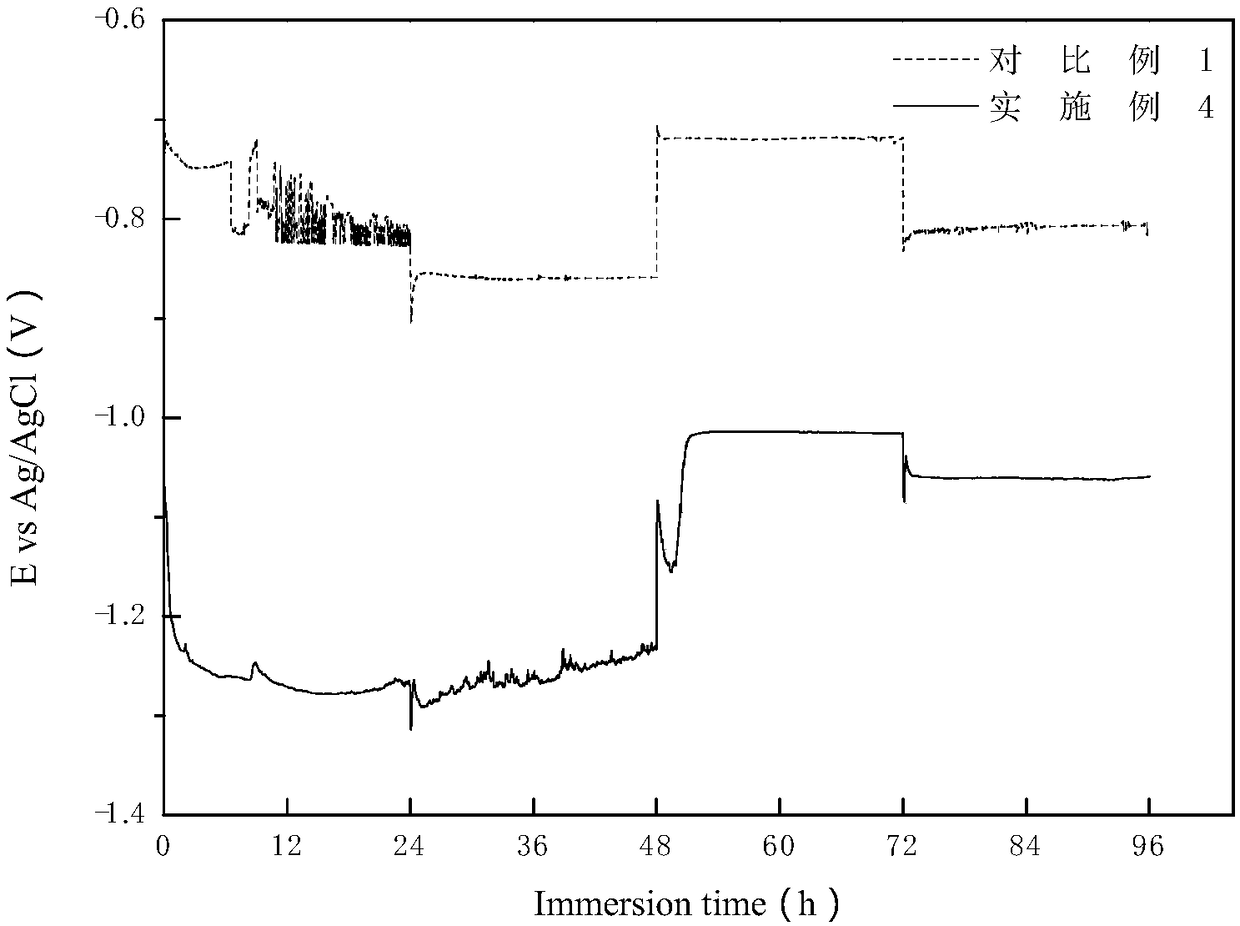Septimal aluminum alloy sacrificial anode material for deep sea environment and preparation method thereof
A sacrificial anode, deep-sea environment technology, used in the field of corrosion and protection of metal materials, can solve the problems of positive potential shift, reduced current efficiency, local corrosion and dissolution, etc., to achieve stable working potential, reduce shrinkage, and promote surface activation.
- Summary
- Abstract
- Description
- Claims
- Application Information
AI Technical Summary
Problems solved by technology
Method used
Image
Examples
Embodiment 1
[0026] The seven-element aluminum alloy sacrificial anode material for deep-sea environment contains the following components by mass percentage: 5.81% zinc, 0.028% indium, 0.12% silicon, 0.2% cerium, 0.03% titanium, 0.5% magnesium, and the balance is aluminum, Among them, the impurity iron is <0.1%.
[0027] Preparation of seven-element aluminum alloy sacrificial anode material for deep sea environment: including the following steps:
[0028] (1) Material pretreatment: Accurately weigh 29.34g of zinc ingot, 0.14g of indium ingot, 2.50g of aluminum-silicon alloy, 3.55g of aluminum-cerium alloy, 1.50g of aluminum-titanium alloy, 25.56g of aluminum-magnesium alloy and 437.42g of aluminum ingot with aluminum foil After wrapping, put it in a drying oven, dry it at 200°C for 24 hours, and take it out for later use;
[0029] (2) Preparation of aluminum alloy sacrificial anode material: Melt the aluminum ingot and aluminum-silicon alloy in step (1) in a crucible resistance furnace, ...
Embodiment 2
[0031] The seven-element aluminum alloy sacrificial anode material for deep-sea environment contains the following components by mass percentage: 5.81% zinc, 0.028% indium, 0.12% silicon, 0.2% cerium, 0.05% titanium, 1.0% magnesium, and the balance is aluminum, Among them, the impurity iron is <0.1%.
[0032] The seven-element aluminum alloy sacrificial anode material for deep-sea environment is made of the following raw materials: 29.34g of zinc ingot with a purity of 99.99%, 0.14g of indium ingot with a purity of 99.99%, 2.50g of an aluminum-silicon alloy with an aluminum content of 24.0%, 3.55g of an aluminum-cerium alloy with an aluminum content of 28.19%, 2.50g of an aluminum-titanium alloy with an aluminum content of 10%, 51.12g of an aluminum-magnesium alloy with an aluminum content of 9.78%, and 409.08g of an aluminum ingot.
[0033] The preparation method of the seven-component aluminum alloy sacrificial anode material used in the deep-sea environment in the second em...
Embodiment 3
[0035] The seven-element aluminum alloy sacrificial anode material for deep-sea environment contains the following components by mass percentage: 5.81% zinc, 0.028% indium, 0.12% silicon, 0.2% cerium, 0.07% titanium, 1.5% magnesium, and the balance is aluminum, Among them, the impurity iron is <0.1%.
[0036] The seven-element aluminum alloy sacrificial anode material for deep-sea environment is made of the following raw materials: 29.34g of zinc ingot with a purity of 99.99%, 0.14g of indium ingot with a purity of 99.99%, 2.50g of an aluminum-silicon alloy with an aluminum content of 24.0%, 3.55g of an aluminum-cerium alloy with an aluminum content of 28.19%, 3.50g of an aluminum-titanium alloy with an aluminum content of 10%, 76.69g of an aluminum-magnesium alloy with an aluminum content of 9.78%, and 384.43g of an aluminum ingot.
[0037] The preparation method of the seven-component aluminum alloy sacrificial anode material used in the deep-sea environment in this embodime...
PUM
 Login to View More
Login to View More Abstract
Description
Claims
Application Information
 Login to View More
Login to View More - R&D
- Intellectual Property
- Life Sciences
- Materials
- Tech Scout
- Unparalleled Data Quality
- Higher Quality Content
- 60% Fewer Hallucinations
Browse by: Latest US Patents, China's latest patents, Technical Efficacy Thesaurus, Application Domain, Technology Topic, Popular Technical Reports.
© 2025 PatSnap. All rights reserved.Legal|Privacy policy|Modern Slavery Act Transparency Statement|Sitemap|About US| Contact US: help@patsnap.com



